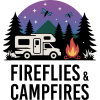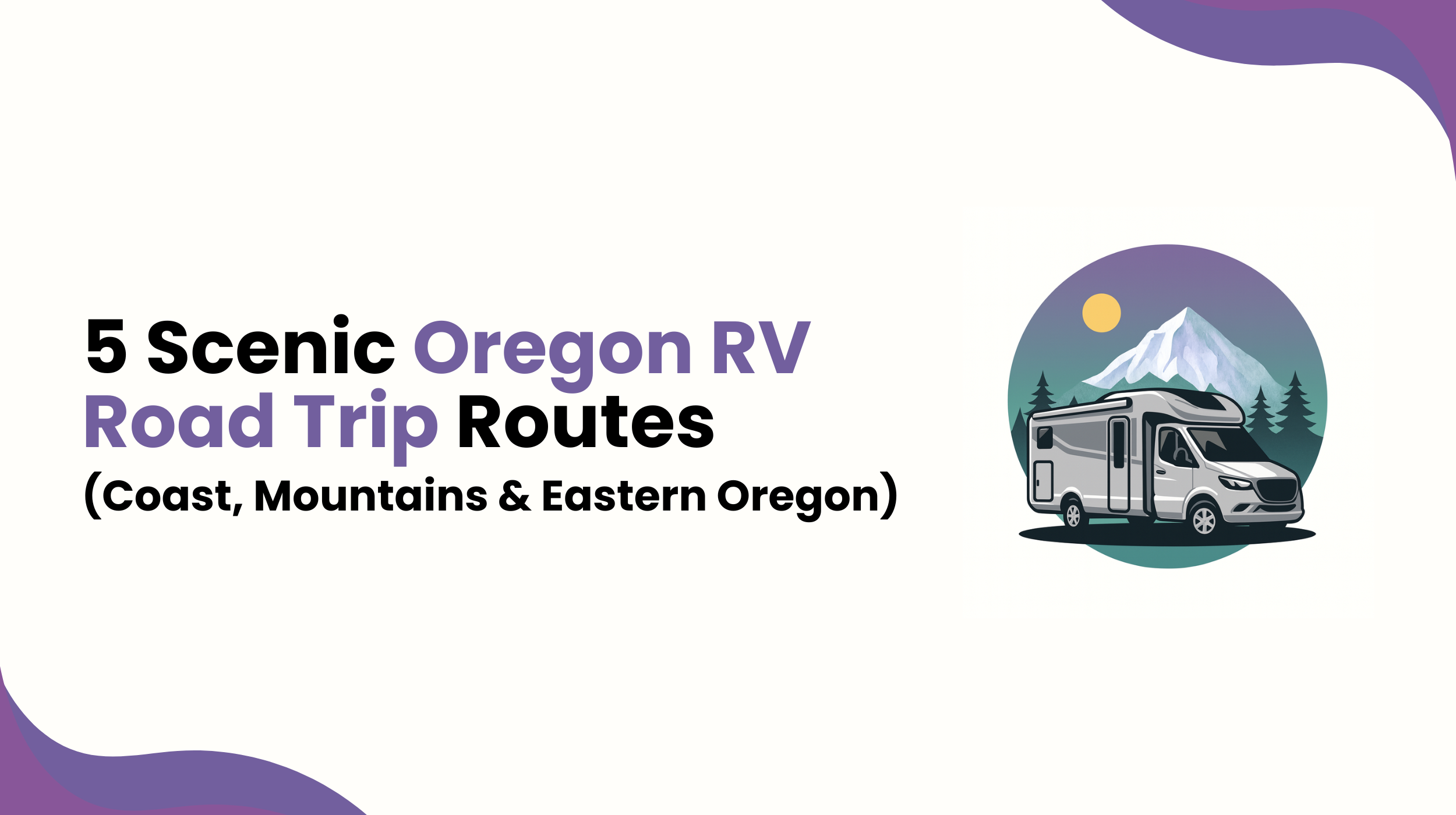TL;DR:
Oregon is one of the most diverse RV destinations in the U.S., offering rugged coastlines, towering mountains, and high-desert wonders. This guide covers 5 distinct Oregon RV road trips, complete with RV-specific tips, must-see stops, and seasonal advice, so you can plan confidently, avoid hassles, and discover hidden gems.
Planning Your Ultimate Oregon RV Road Trip
Few states rival Oregon’s variety of landscapes. From the Pacific Ocean’s dramatic cliffs to the snowy peaks of the Cascades and the quiet solitude of the high desert, an RV is the perfect way to see it all at your own pace. In 2024, visitors spent over $14.3 billion on Oregon tourism, proof that the state’s natural wonders are in high demand.
In this guide, we’ll cover five unique RV-friendly road trips:
- The Classic Coastal Explorer – Oregon’s Pacific Coast Scenic Byway
- The Mountain Majesty Loop – Mount Hood & Cascade Lakes
- The High Desert & Painted Hills Adventure – John Day Fossil Beds & beyond
- Southern Oregon’s Volcanic Legacy – Crater Lake & waterfalls
- Historic Columbia River Gorge Waterfall Corridor – Oregon’s iconic waterfalls
Each route is paired with insider tips on parking, campsites, and realistic drive times to help you plan smarter and travel smoothly.
When is the Best Time to Visit Oregon in an RV?
Honestly, just about any time is a great time to visit Oregon. Here are some reasons for each season.
- Spring: Great for storm watching on the coast, wildflower blooms in Eastern Oregon, and roaring waterfalls in the Columbia Gorge.
- Summer: Warm weather, long days, and peak crowds. Book campsites early and watch for wildfire risks in mountain and desert regions.
- Fall: Crisp days, stunning foliage in the Cascades, and cranberry harvest season on the coast. A quieter, underrated time to travel.
- Winter: The coast shines with milder weather and fewer crowds. Many mountain passes (like McKenzie Pass) close due to snow, so plan carefully.
Essential Tips for RV Travel in Oregon
Traveling Oregon in an RV is incredible, but it comes with quirks you’ll want to prepare for:
- Narrow, Winding Roads: Highway 101 and scenic byways can feel tight for large rigs. Drive cautiously and allow more time than maps suggest.
- Parking Challenges: Popular trailheads and coastal towns often lack RV parking. Use state parks or large-lot attractions like Tillamook Creamery for easier stops.
- Book Early: Summer campsites at Oregon State Parks fill months in advance. Reserve via Recreation.gov.
- State Parks Pass: A $30 annual Oregon State Parks pass pays for itself quickly if you’re hopping between parks.
- Fueling Up: Oregon updated its rules in 2023. You may pump your own gas now, but attendants are often still available.
Route 1: The Classic Coastal Explorer (Pacific Coast Scenic Byway)
Overview: 363 miles | 5-7 days
Route: Astoria → Cannon Beach → Tillamook → Newport → Florence → Brookings
Highlights include:
- Astoria: Visit The Goonies film sites, tour Fort Stevens State Park (with RV camping).
- Cannon Beach: Iconic Haystack Rock; park at Tolovana Beach for RV space.
- Tillamook Creamery: Free cheese samples and a massive RV-friendly lot.
- Newport: Explore Yaquina Head Lighthouse and stay at South Beach State Park.
- Cape Perpetua: Stunning coastal hikes and tide pools.
- Samuel H. Boardman Scenic Corridor: Perhaps Oregon’s most photogenic coastline.
- Where to Stay: Fort Stevens State Park, South Beach State Park, Harris Beach State Park.
Pro Tip: Drive north-to-south for ocean views on the passenger side and easier turnouts.
Route 2: The Mountain Majesty Loop (Mount Hood & Cascade Lakes)
Overview: 250 miles | 4-5 days
Route: Portland → Mount Hood → Bend → Cascade Lakes Scenic Byway → back north
Highlights include:
- Columbia River Gorge: Kick off with waterfalls like Multnomah Falls (use shuttle or visit midweek for RV parking).
- Mount Hood Scenic Byway: Stop at Timberline Lodge and Trillium Lake for classic mountain views.
- Bend: Basecamp for breweries, hiking, and outdoor activities.
- Cascade Lakes Scenic Byway: Dozens of lakes and campgrounds (seasonally closed in winter).
- Where to Stay: Deschutes National Forest campgrounds, Mount Hood RV Village.
Pro Tip: Sites around Mount Hood book out months in advance so reserve early.
Route 3: The High Desert & Painted Hills Adventure (Eastern Oregon)
Overview: 400 miles | 3-4 days
Route: John Day Fossil Beds → Painted Hills → Sheep Rock → Clarno
Highlights include:
- Painted Hills: Iconic, colorful clay formations.
- Sheep Rock Unit: Museum of fossils dating back 50 million years.
- Clarno Unit: Fossil-rich cliffs and quiet hiking trails.
- Optional Extension: Wallowa Mountains and Hells Canyon for remote beauty.
- Where to Stay: Clyde Holliday State Park or dispersed camping near John Day.
Pro Tip: Services are scarce. Fuel up before heading east and download offline maps.
Route 4: Southern Oregon’s Volcanic Legacy (Crater Lake & Waterfalls)
Overview: 140 miles | 3-4 days
Route: Crater Lake NP → Rogue-Umpqua Scenic Byway
Highlights include:
- Crater Lake National Park: Deepest lake in the U.S. so visit when Rim Drive is fully open (typically July-September). RVs may struggle with tight parking, so plan ahead.
- Toketee Falls: Famous columnar basalt waterfall, with limited parking for larger rigs.
- Rogue-Umpqua Scenic Byway: Known as the “Highway of Waterfalls,” dotted with dozens of accessible cascades.
- Where to Stay: Mazama Campground (inside the park, book early), Diamond Lake RV Park.
Route 5: The Historic Columbia River Gorge Waterfall Corridor
Overview: 70 miles | 2-3 days
Route: Troutdale → Vista House → Multnomah Falls → Hood River
Highlights include:
- Vista House at Crown Point: Panoramic Columbia River Gorge views.
- Multnomah Falls: Oregon’s most famous waterfall, so arrive early for limited RV parking.
- Latourell & Horsetail Falls: Quieter, equally beautiful alternatives.
- Hood River: A fun end-point with breweries, fruit stands, and river views.
- Where to Stay: Ainsworth State Park Campground, Viento State Park.
Pro Tip: In peak summer, timed-use permits are required for the “waterfall corridor.” Consider shuttles to avoid parking headaches.
Frequently Asked Questions
What is the most scenic coast drive in Oregon?
The Pacific Coast Scenic Byway is unbeatable, but don’t miss the Three Capes Scenic Loop near Tillamook or the Samuel H. Boardman Corridor near Brookings for extra jaw-dropping views.
How many days do you need on the Oregon Coast road trip?
3-5 days works well for highlights, though a full week allows you to explore at a relaxed pace.
What is the best road trip in Oregon?
It depends on your interests. Top contenders are the Pacific Coast Scenic Byway (coastline), Cascade Lakes Scenic Byway (mountains), and the Hells Canyon Scenic Byway (remote beauty).
How do I plan an unforgettable Oregon coast road trip?
Choose a direction (north-to-south is best), book campsites months in advance, and build in time for must-sees like Astoria, Cannon Beach, and Newport.

